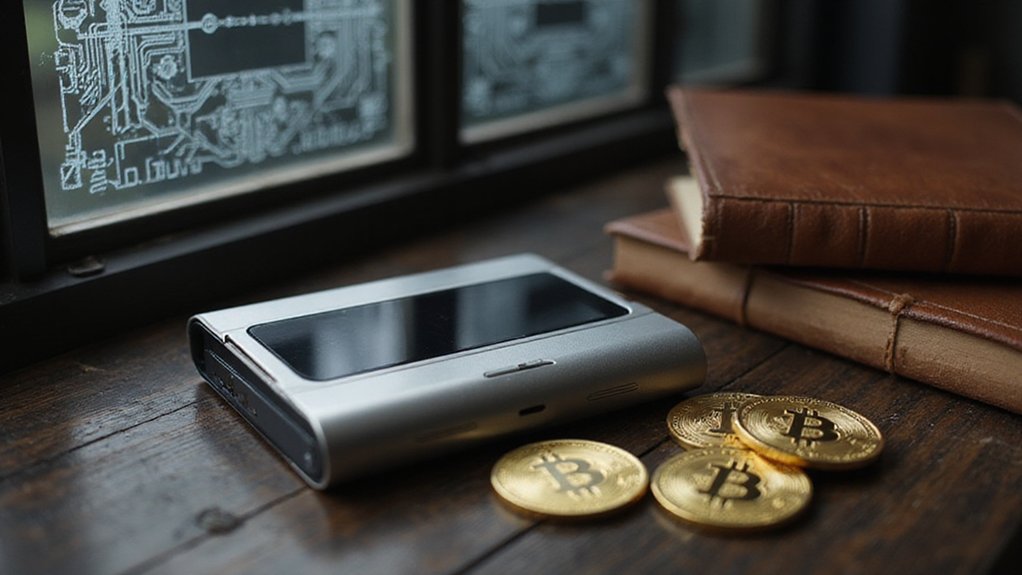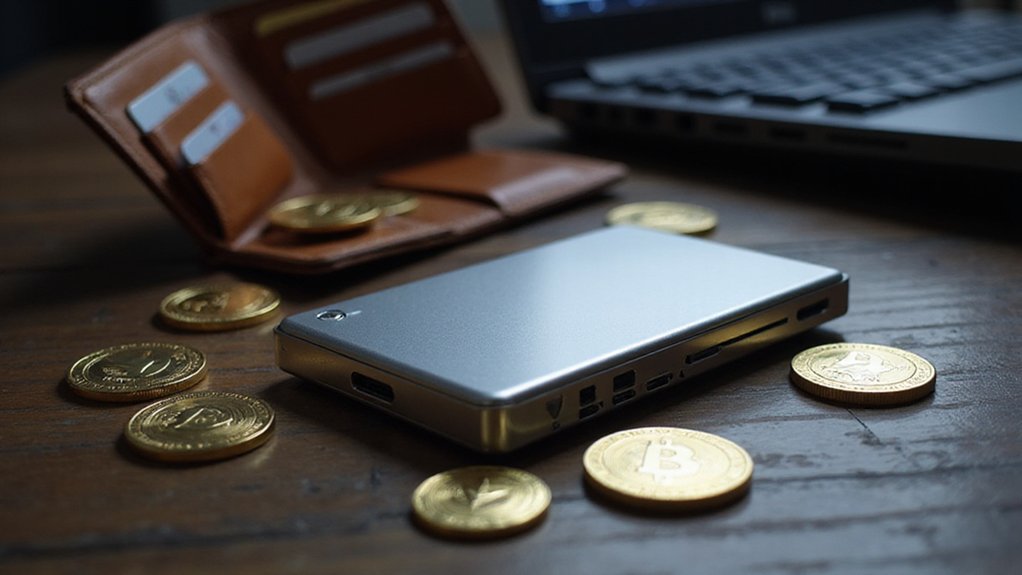A self-custody wallet grants users exclusive control over their cryptocurrency private keys, eliminating financial intermediaries while transferring institutional responsibilities directly to the individual. Unlike custodial services, these wallets—whether software, hardware, or multi-signature configurations—store private keys rather than actual cryptocurrencies, with true ownership derived from key control rather than account balances. This autonomy naturally comes with the sobering recognition that lost keys mean permanently inaccessible funds, though deeper exploration reveals additional nuances worth considering.

While the financial world has spent decades perfecting the art of intermediation—creating layers upon layers of institutions between individuals and their money—self-custody wallets represent a rather radical departure from this well-established tradition of letting someone else hold the keys to one’s wealth.
A self-custody wallet operates on the premise that users maintain exclusive control over their private keys, those cryptographic secrets that actually govern access to blockchain-based assets. Unlike custodial arrangements where exchanges or service providers hold these keys (ostensibly for safekeeping), self-custody eliminates the middleman entirely, transforming users into their own banks—complete with all the accompanying responsibilities that traditional financial institutions have historically shouldered.
Self-custody eliminates financial intermediaries entirely, transforming users into their own banks—complete with all the accompanying institutional responsibilities.
The mechanics are deceptively straightforward: the wallet stores private keys rather than cryptocurrencies themselves, since digital assets exist on the blockchain and can only be accessed through proper cryptographic authorization. This distinction matters considerably more than it might initially appear, as true ownership derives from key control rather than account balances displayed on some third party’s interface.
Self-custody manifests in various forms, from software applications residing on personal devices to hardware wallets that maintain offline key storage. Multi-signature configurations require multiple private keys for transaction authorization, while paper wallets embrace the rather ironic approach of storing digital assets through decidedly analog means. Web3 wallets extend functionality beyond mere storage, enabling interaction with decentralized applications through browser extensions.
The security implications prove both liberating and terrifying. Users escape the risks of centralized hacks and institutional mismanagement, yet assume complete responsibility for safeguarding their keys. Lost private keys mean permanently inaccessible funds—no customer service department can restore access to mathematically secured assets. This arrangement offers no deposit insurance, no fraud protection, and no recovery assistance beyond whatever backup measures users implement themselves. Critical incidents such as the Mt. Gox hack demonstrate precisely why relying on third parties to secure digital assets can result in catastrophic losses for users.
Custodial alternatives provide user-friendly recovery options and customer support, often at the cost of actual asset control and transparency. Some custodial services engage in lending or other activities using customer funds, while self-custody guarantees assets remain under direct owner control. However, regulatory changes can affect access to certain cryptocurrency services, as some providers have restricted certain webpages in response to evolving legal requirements. Self-custody wallets align naturally with the decentralized finance movement, enabling direct participation in peer-to-peer transactions without requiring traditional banking intermediaries.
The trade-off between convenience and sovereignty becomes particularly stark when considering that self-custody transforms every user into a potential target requiring sophisticated security practices previously managed by specialized institutions.
Frequently Asked Questions
Can I Recover My Self-Custody Wallet if I Lose My Private Keys?
No, lost private keys in self-custody wallets cannot be recovered—the entire architecture deliberately eliminates third-party intervention.
However, users who maintained proper backup protocols (seed phrases stored securely offline, hardware wallet recovery mechanisms, or encrypted redundant copies) can restore access through compatible wallet applications.
The irony remains stark: absolute financial sovereignty demands absolute personal accountability, transforming careless key management from mere inconvenience into permanent asset forfeiture.
What Happens to My Crypto if the Wallet Provider Shuts Down?
If one’s wallet provider shuts down, self-custody users retain complete access to their cryptocurrency—the funds remain untouched on the blockchain, controlled by private keys rather than corporate infrastructure.
Custodial wallet users, however, face potential asset freezing or permanent loss, as their funds sit in provider-controlled accounts.
The distinction proves rather consequential: self-custody means independence from corporate mortality, while custodial arrangements create dependency on provider solvency and operational continuity.
Are Self-Custody Wallets Compatible With All Cryptocurrencies and Tokens?
Self-custody wallets exhibit impressive compatibility with major cryptocurrencies like Bitcoin and Ethereum, plus countless ERC-20 tokens—though “all” remains tantalizingly elusive.
Hardware limitations and software constraints inevitably create gaps, particularly with obscure altcoins or emerging blockchain protocols. While many wallets support multiple networks and offer custom token additions, users shouldn’t assume universal compatibility.
Given previous discussions about provider shutdowns, this limitation proves less catastrophic since private key control transcends specific wallet software.
How Much Does It Cost to Set up and Maintain a Self-Custody Wallet?
Self-custody wallet costs vary dramatically by type: hardware wallets demand $50-200 upfront, while software versions remain free (though compatible devices aren’t).
Beyond initial setup, users face ongoing blockchain transaction fees—those delightful gas costs that fluctuate with network congestion.
Maintenance expenses include secure backup storage solutions and periodic updates, yet significantly absent are the recurring custodial fees that traditional services impose.
The primary cost? One’s time investment in mastering proper security protocols.
Can I Use Multiple Self-Custody Wallets for the Same Cryptocurrency Simultaneously?
Yes, users can operate multiple self-custody wallets for identical cryptocurrencies simultaneously—each wallet maintains independent private keys and addresses without technical conflicts.
This strategy actually enhances security by compartmentalizing assets across separate seed phrases, preventing total loss from single-point failures.
Smart holders often deploy multiple wallets strategically: hardware devices for long-term storage, mobile wallets for daily transactions, and dedicated wallets for specific purposes like DeFi or business operations.









